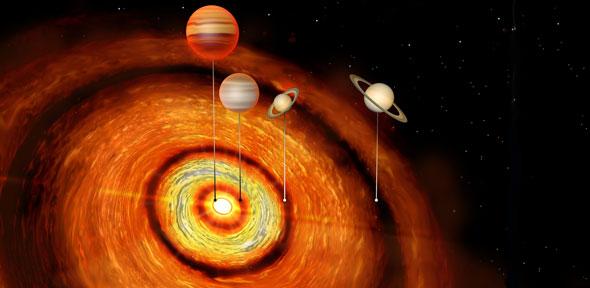Record Breaker: 4 Huge Alien Planets Spotted Around Baby Star

In an astronomical first, four gigantic planets have been detected around a very young star, a new study reports.
The star in question is CI Tau, which lies about 500 light-years from Earth. CI Tau is just 2 million years old and is still surrounded by a swirling clump of dust and gas known as a protoplanetary disk.
The star was already known to host one planet, a world about 10 times more massive than Jupiter that circles CI Tau once every nine Earth days. This planet, called CI Tau b, was the first "hot Jupiter" ever discovered around such a young star. [Gallery: The Strangest Alien Planets]
In the new study, a team of researchers observed CI Tau and its disk with the Atacama Large Millimeter/submillimeter Array (ALMA), a network of radio telescopes in the Chilean Andes. ALMA spotted three additional gaps in the disk, at distances of 13, 39 and 100 astronomical units (AU) from the star, the astronomers report. (One AU is the Earth-sun distance — about 93 million miles, or 150 million kilometers).
So it seems that CI Tau b has three siblings. And these newfound worlds are big, too: The team's work suggests the innermost of the three is about as massive as Jupiter, while the outer two have Saturn-esque heft.
Astronomers had never spotted four gas-giant planets around such a young star before, study team members said. And the orbital range — the outermost planet lies about 1,000 times farther from CI Tau than the innermost world does — is extreme as well, the researchers added.
Indeed, it's unclear how the two outermost planets were able to take shape.
Breaking space news, the latest updates on rocket launches, skywatching events and more!
"Saturn-mass planets are supposed to form by first accumulating a solid core and then pulling in a layer of gas on top, but these processes are supposed to be very slow at large distances from the star," study lead author Cathie Clarke, of the Institute of Astronomy at the University of Cambridge in England, said in a statement. "Most models will struggle to make planets of this mass at this distance."
It's also unclear what role, if any, the sibling planets played in driving CI Tau b to its super-tight orbit, study team members said. Observing the bizarre system further with other telescopes may help answer these and other questions, study team members said.
The new paper was published this month in The Astrophysical Journal Letters.
Mike Wall's book about the search for alien life, "Out There," will be published on Nov. 13 by Grand Central Publishing. Follow him on Twitter @michaeldwall. Follow us @Spacedotcom or Facebook. Originally published on Space.com.

Michael Wall is a Senior Space Writer with Space.com and joined the team in 2010. He primarily covers exoplanets, spaceflight and military space, but has been known to dabble in the space art beat. His book about the search for alien life, "Out There," was published on Nov. 13, 2018. Before becoming a science writer, Michael worked as a herpetologist and wildlife biologist. He has a Ph.D. in evolutionary biology from the University of Sydney, Australia, a bachelor's degree from the University of Arizona, and a graduate certificate in science writing from the University of California, Santa Cruz. To find out what his latest project is, you can follow Michael on Twitter.
